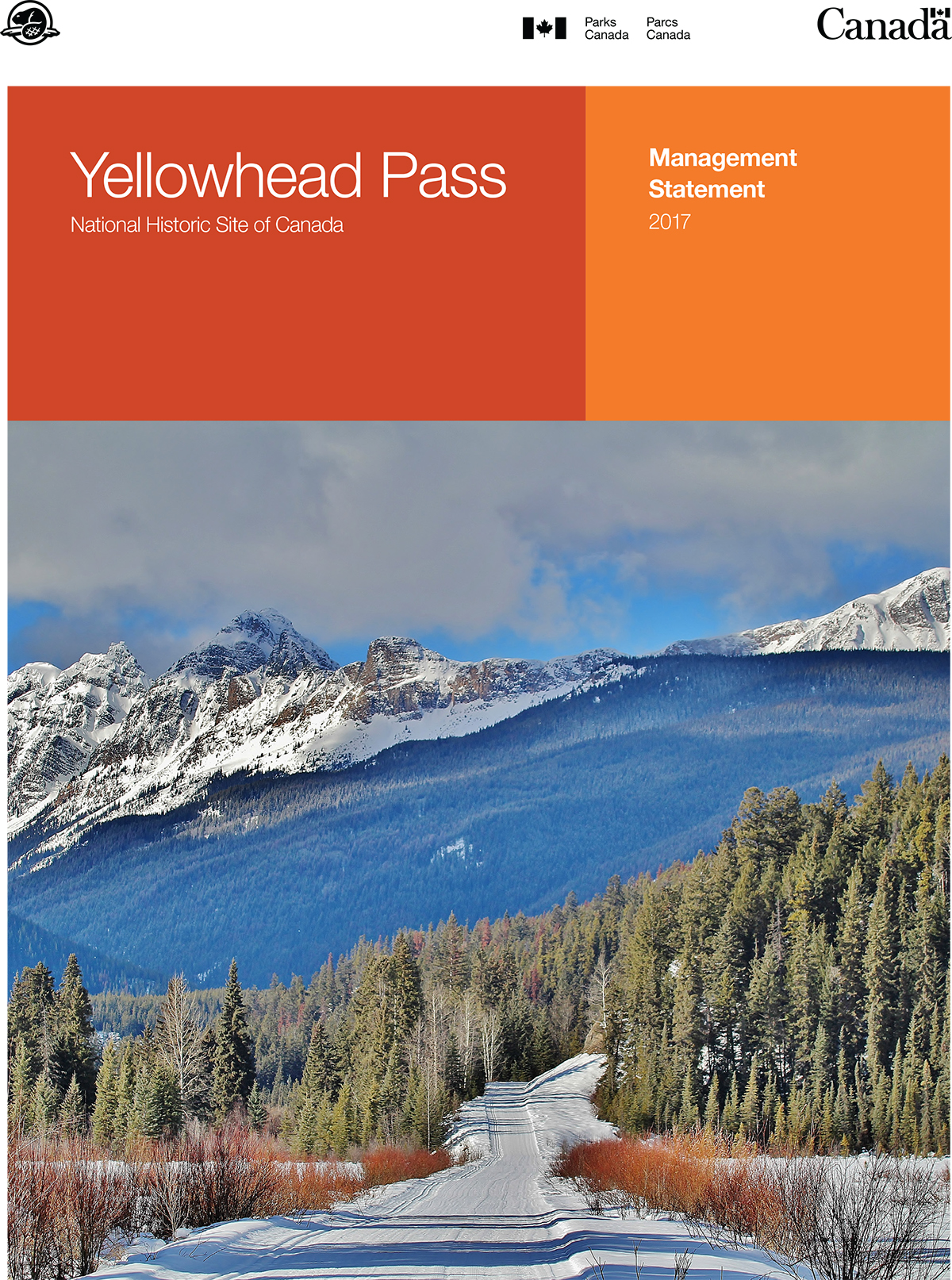Yellowhead Pass National Historic Site of Canada Management Statement
Yellowhead Pass National Historic Site
Table of contents

© Her Majesty the Queen in Right of Canada, represented by the Chief Executive Officer of Parks Canada, 2017
Cette publication est aussi disponible en français.
For more information about the management statement or about Yellowhead National Historic Site of Canada:
PO Box 10
Jasper, AB T0E 1E0
Canada
Approval
Approved on December 22, 2017 by:
Alan Fehr
Field Unit Superintendent
Jasper National Park
Parks Canada
Introduction
The Parks Canada Agency manages one of the finest and most extensive systems of protected natural and historic areas in the world. The Agency’s mandate is to protect and present these places for the benefit and enjoyment of current and future generations. This management statement outlines Parks Canada’s management approach and objectives for Yellowhead Pass National Historic Site.
Jasper House National Historic Site of Canada is located at a once-strategic point on routes through both Yellowhead Pass and the Athabasca Pass in the Canadian Rockies, approximately 35 km east of Jasper, Alberta. It was also strategically located for Indigenous people traveling through Snake Indian Pass into the upper Smoky River drainage, the Fraser River drainage and the interior of British Columbia.
First established by the North West Company in 1813, Jasper House was relocated in 1830 to the west bank of the upper Athabasca River near the north end of Jasper Lake, and became the centre of a modest and diverse community and an important staging post for travelers, serving as a warehouse for those crossing the two passes.
At 1,133 m, the Yellowhead Pass National Historic Site of Canada is one of the lowest elevation passes across the Continental Divide in the Northern Rockies. Used by Indigenous people for millennia, the pass became an important connection to the fur trade country of the upper Fraser River and New Caledonia from c1825-1853. Its significance as a transportation route evolved, with the construction of two new transcontinental railways, the Grand Trunk Pacific and the Canadian Northern Railway, between 1906 and 1915 along the Yellowhead route. The two routes were later amalgamated into one. The CN Railway line and the abandoned rail grades were subsequently used by automobiles as the first Yellowhead Highway. The significance of Yellowhead Pass as a major transportation route has continued to evolve since the 1950s as a pipeline, highway, railway and telecommunications corridor.
A large-scale cultural landscape, this historic site stretches from the junction of highways 16 and 93 in Jasper National Park, Alberta to Fraser Crossing in Mount Robson Provincial Park, British Columbia, a distance of approximately 37 km. Valued for its scenic beauty, the site’s strong sense of place and time derives as much from its scenery and landscape as from the presence of specific historic or cultural resources. While the area is rich in cultural resources (abandoned rail features and early highway rights-of-way, townsites and camps), it is the sum of its parts that makes this site a special place – the combination of landforms and human-engineered changes. The pass is an active transportation corridor that will continue to evolve.
Management approach
Yellowhead Pass is managed within the respective policy, legislative and regulatory frameworks of Jasper National Park and Mount Robson Provincial Park. Parks Canada administers the section of the historic site located within Jasper National Park, while the Province of British Columbia manages the portion of the pass within Mount Robson Provincial Park, under the jurisdiction of BC Parks, part of the provincial Ministry of Environment. In addition, CN Railway administers the land within their right-of-way for railway purposes. Other land tenures and permits exist for the pipeline, utilities infrastructure, and for the occupation of three private cabins in the British Columbia portion of Yellowhead Pass.
The situation of the pass within two protected areas provides the opportunity to continue to strengthen working arrangements between Parks Canada and the Province of British Columbia. Effective relationships with managers of transportation infrastructure are essential to the long-term protection and commemoration of cultural resources located within the site, and the broader ecological integrity of the national park. Parks Canada has existing working relationships with CN Railway and Kinder-Morgan to support and advance shared stewardship of the Yellowhead Pass.
For a map, please refer to: http://www.pc.gc.ca/en/lhn-nhs/ab/yellowhead/visit.
Management objectives
- Parks Canada protects the cultural and natural resources of the Yellowhead Pass to ensure the commemorative integrity of the national historic site and the ecological integrity of Jasper National Park. Working with others, Parks Canada preserves elements that define the character of the historic site and give meaning to the overall pattern of the cultural landscape, including landforms, transportation, and other significant built features.
- Parks Canada works cooperatively with partners and stakeholders to enhance the understanding, awareness and visitor experience opportunities of the site and the family of national historic sites associated with Yellowhead Pass and Jasper National Park.
- Parks Canada facilitates off-site experiences and learning opportunities for people unable to visit Yellowhead Pass through an educational and engaging communication and interpretation program.
- Parks Canada maintains effective working relationships with the Province of British Columbia, CN Railway, Kinder-Morgan and others to support the commemoration of Yellowhead Pass as a modern, active and evolving transportation corridor, while ensuring that the management of the site respects jurisdictions and shared goals and objectives for protection, interpretation, and visitor experience.
- Parks Canada works collaboratively with Indigenous Peoples in the planning, management and operations of our heritage places and is committed to building mutually beneficial relationships with Indigenous communities, based on trust, respect and understanding. In managing Yellowhead Pass National Historic Site, Parks Canada works with interested Indigenous communities associated with Jasper National Park to incorporate traditional knowledge and values into the protection, interpretation and visitor experience of the area.
Related links
- Date modified :